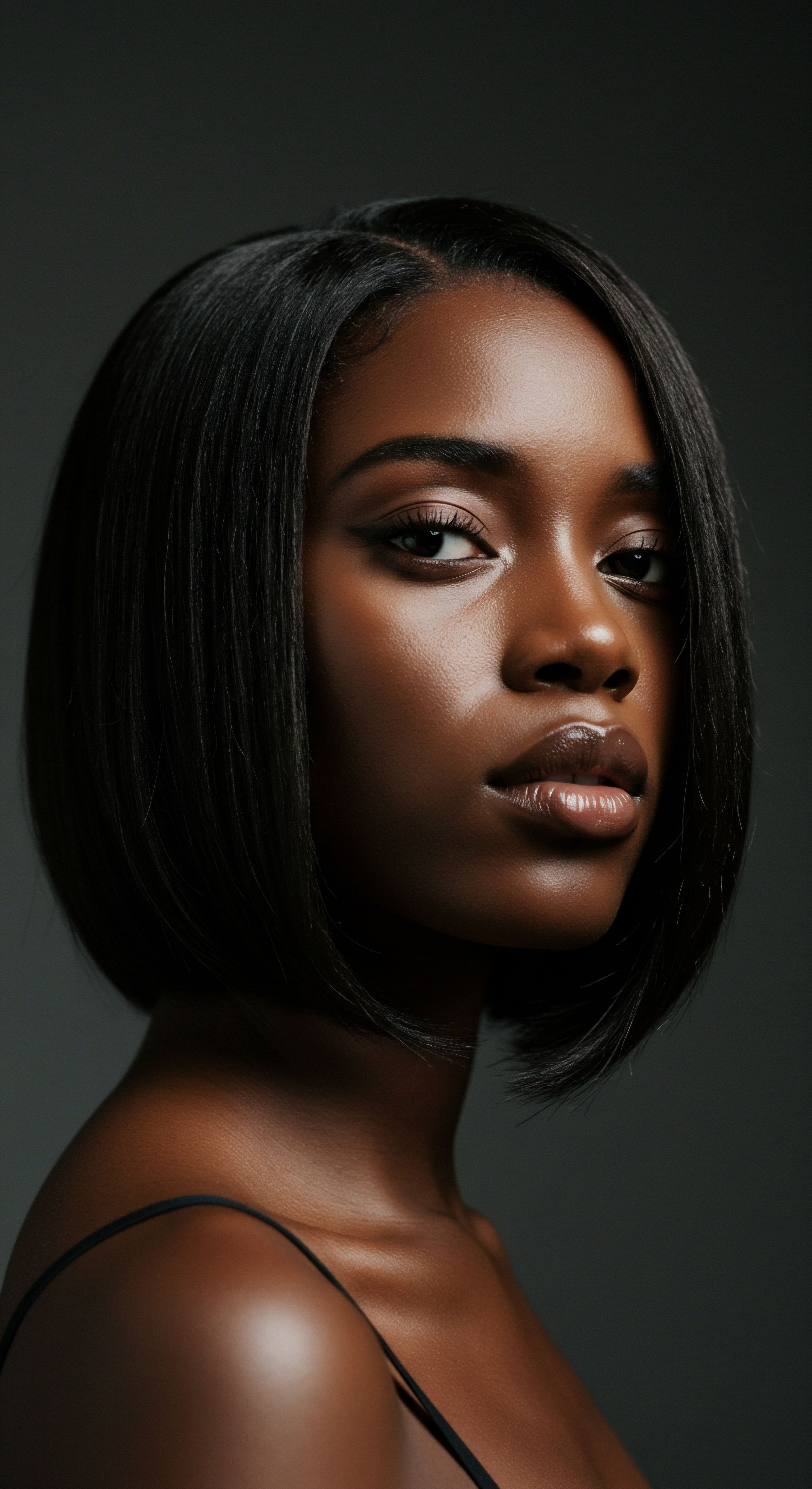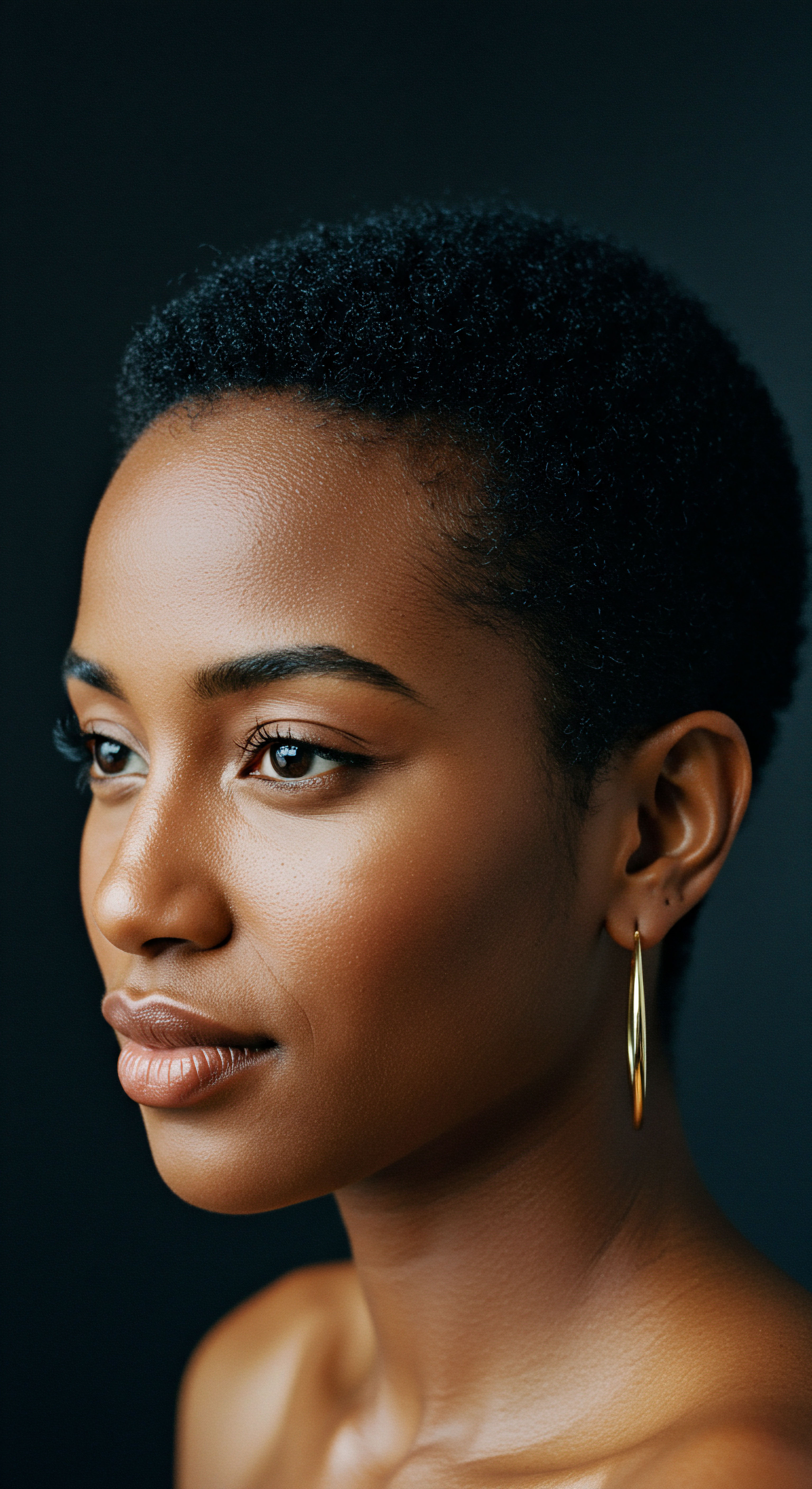
Roots
The whisper of hair through time carries more than mere styling trends; it speaks of ancient wisdom, of hands tending to strands with a deep understanding of their nature, and of tools crafted from the very earth. Our modern quest for smooth, tangle-free hair, particularly for those with textured curls and coils, often feels like a contemporary challenge. Yet, the foundations of effective detangling reach back across millennia, to civilizations where hair care was an integral part of life, status, and well-being.
By observing the past, we uncover not just techniques, but a philosophy of care that prioritizes preservation and gentle interaction with the hair fiber. This exploration begins by unearthing the fundamental principles that guided our ancestors, revealing how their intimate knowledge of hair and natural resources continues to shape the choices we make today.

Ancient Approaches to Hair Fiber Integrity
Long before the advent of synthetic conditioners or specialized detangling brushes, people relied on the bounty of nature to manage their hair. Ancient Egyptians, for instance, utilized oils like Castor Oil and Almond Oil for their moisturizing and protective qualities, shielding hair from the harsh desert climate and aiding in manageability. These oils, applied with care, would have provided a natural slip, allowing fingers or rudimentary combs to glide through strands with less friction. The wisdom held that a well-lubricated strand was a resilient strand, less prone to the breakage that tangles invite.
Historical hair care practices often emphasized natural lubrication and gentle manipulation, laying the groundwork for modern detangling principles.
In the ancient Indian tradition of Ayurveda, hair care was a holistic practice. Texts dating back thousands of years describe the use of natural ingredients such as Amla, Shikakai, and Neem for cleansing and nourishing the scalp and hair. These botanicals possessed inherent conditioning properties that would have softened hair, making it easier to manage and less prone to knotting. The emphasis was on overall hair health, recognizing that healthy hair, from root to tip, naturally resists tangles more effectively.

What Early Tools Guided Hair Management?
The earliest tools for hair management were often extensions of the human hand or simple natural implements. Archaeological findings across various ancient civilizations reveal combs crafted from materials like wood, bone, and ivory. These combs, with their often wider teeth, were designed to separate strands rather than rip through them.
The slow, deliberate motion of using such tools, combined with natural emollients, underscores a patience with the hair fiber that is sometimes lost in our fast-paced world. For instance, ivory combs discovered in Banawali and Kalibangan suggest that regular detangling was a practice during the Harappan civilization.
- Finger Detangling ❉ A practice that has endured for centuries, relying on the sensitivity of touch to navigate knots gently and minimize breakage.
- Wide-Toothed Combs ❉ Crafted from natural materials, these early combs facilitated separation of hair strands without excessive pulling.
- Brushes with Natural Bristles ❉ Tools like boar bristle brushes were used historically to distribute scalp oils and mechanically remove debris, aiding in smoothing the hair and preventing tangles.
The historical practice of dry detangling, particularly with the aid of light oils, stands in contrast to many modern recommendations for textured hair. One notable perspective highlights that historical women often detangled their hair dry, frequently achieving very long hair. This suggests a connection between dry detangling and length retention, challenging the contemporary emphasis on wet detangling for curly hair types. The logic presented is that fingers, unlike inanimate combs or brushes, can feel and negotiate every knot, thereby minimizing breakage.
| Ingredient Castor Oil |
| Historical Application Used in Ancient Egypt for moisturizing and protection. |
| Detangling Benefit Provides slip, reduces friction, aids in smooth separation of strands. |
| Ingredient Almond Oil |
| Historical Application Combined with castor oil in Egyptian practices. |
| Detangling Benefit Softens hair, adds lubrication, makes hair more pliable. |
| Ingredient Olive Oil |
| Historical Application Staple in Ancient Greece and Rome for conditioning. |
| Detangling Benefit Moisturizes, adds sheen, helps smooth the hair cuticle. |
| Ingredient Coconut Oil |
| Historical Application Deeply rooted in ancient Ayurvedic practices, used in India and tropical regions. |
| Detangling Benefit Penetrates hair shaft, reduces protein loss, provides deep moisturization. |
| Ingredient Clay (e.g. Rhassoul) |
| Historical Application Used by ancient civilizations for cleansing without stripping oils. |
| Detangling Benefit Cleanses gently, leaves hair soft, can aid in clumping curls for easier management. |
| Ingredient These natural elements were foundational to historical hair care, contributing significantly to detangling ease. |

Ritual
Stepping from the foundational wisdom of hair’s elemental nature, we arrive at the deliberate, often repeated actions that transformed simple care into meaningful practice. The way we approach detangling today, whether as a hurried chore or a mindful moment, carries echoes of these historical rituals. Understanding these echoes helps us appreciate the depth behind modern methods and tool choices, recognizing that each brush stroke or finger glide is part of a long lineage of human interaction with hair. This section delves into the patterned behaviors and the subtle shifts in application that have shaped our present-day detangling routines, revealing the enduring power of purposeful hair care.

How Did Ancient Societies Systematize Hair Care?
Across various cultures, hair care was rarely a haphazard activity. Instead, it was often a formalized process, sometimes even tied to social status or spiritual beliefs. In ancient India, the practice of Hair Oiling, or ‘Champi’, was a central part of the daily regimen, known as ‘dincharya’.
This ritual involved coating the hair with nutrient-rich oils and massaging them into the scalp, a practice believed to strengthen roots, prevent premature graying, and alleviate headaches. The consistent application of oils would have kept hair lubricated, making it less prone to tangles and breakage during subsequent manipulation.
The consistent application of oils in historical rituals created a foundation for easier hair management, reducing the incidence of stubborn knots.
Medieval Europeans, despite less frequent full washes, maintained hair cleanliness through meticulous routines involving combs, brushes, and protective styling. Long hair was often braided and pinned up, keeping it from tangling and minimizing breakage. This protective styling, similar to methods used in textured hair care today, reduced the need for aggressive detangling. The regular brushing, sometimes twice daily, with fine-toothed combs, also served to remove debris and distribute natural scalp oils, contributing to smoother, more manageable hair.

What Lessons From Historical Rituals Guide Modern Detangling?
The principles of historical hair care, though often executed with simpler tools, hold profound relevance for modern detangling. The emphasis on pre-conditioning with oils, for instance, directly influences the modern use of pre-poo treatments and detangling sprays. These products mimic the lubricating and softening effects of ancient oils, creating “slip” that allows detangling tools to move through hair with minimal resistance.
Consider the impact of Dry Detangling, a practice common in historical hair care, especially for those with long hair. While modern curly hair care often advocates for wet detangling, some proponents of historical methods suggest that dry detangling with light oils can actually reduce breakage, particularly for very dry hair. This perspective highlights the importance of feeling each knot and gently negotiating it with fingers, rather than relying on a comb or brush to power through. The choice between wet and dry detangling, or a hybrid approach, becomes a personal ritual informed by these historical insights and individual hair needs.
The communal aspect of hair grooming in some ancient African communities, where hair care was a social event, fostered careful and patient handling. This communal care inherently reduced the likelihood of aggressive detangling, as multiple hands could work through sections with greater gentleness. This historical context encourages a mindful, patient approach to detangling, whether alone or with assistance, prioritizing hair health over speed.
| Historical Ritual Pre-Wash Oiling (Champi) |
| Modern Detangling Parallel Pre-Poo Treatments, Detangling Sprays |
| Shared Underlying Principle Lubrication and softening of hair before manipulation. |
| Historical Ritual Protective Braiding/Updos |
| Modern Detangling Parallel Protective Styles (Braids, Twists, Buns) |
| Shared Underlying Principle Minimizing tangles by securing hair and reducing friction. |
| Historical Ritual Regular Dry Brushing/Combing |
| Modern Detangling Parallel Finger Detangling, Gentle Dry Brushing with Oils |
| Shared Underlying Principle Mechanical removal of debris, oil distribution, careful knot negotiation. |
| Historical Ritual Use of Natural Conditioners (Herbs, Clays) |
| Modern Detangling Parallel Deep Conditioners, Hair Masks, Clay Washes |
| Shared Underlying Principle Infusing moisture and nutrients to improve hair elasticity and smoothness. |
| Historical Ritual Many modern detangling strategies echo the foundational practices of historical hair care. |

Relay
As we trace the lineage of hair care, a profound connection emerges between ancestral practices and the nuanced science of modern detangling. The journey from ancient remedies to contemporary solutions is not a linear progression of replacement, but a rich relay, where insights from the past inform and refine our present understanding. This section bridges historical approaches with current scientific knowledge, revealing how traditional methods laid the groundwork for sophisticated detangling tools and techniques, particularly for textured hair. We will delve into the underlying biological and cultural factors that make certain historical practices so enduringly effective, and how they continue to influence the choices we make for our strands today.

How Do Hair Biology and Historical Practices Align?
The physical properties of hair, particularly its curl pattern and porosity, significantly influence detangling. Afro-textured hair, characterized by its thick, tiny, spiral-shaped curls, often presents unique detangling challenges due to its propensity for tangling and knotting. Historically, cultures with a prevalence of textured hair developed practices that inherently respected these characteristics. The widespread use of oils in African and Indian hair care, for example, directly addresses the need for lubrication in highly coiled strands, which struggle to distribute natural sebum down the hair shaft.
Research in modern hair science confirms the efficacy of these historical oiling practices. Studies on coconut oil, for instance, highlight its ability to penetrate the hair shaft, preventing protein loss and improving overall hair structure. Similarly, jojoba oil, historically used by Native American tribes for its moisturizing properties, helps balance the scalp’s natural oils and improves manageability in contemporary products. This scientific validation underscores that ancient applications were not merely anecdotal; they were intuitively aligned with hair biology.
Consider the compelling observation by Katherine, a practitioner of historical hair care, who shares her experience of growing her curly hair to hip length by largely abandoning wet detangling in favor of Dry Detangling with Light Oils. She notes that while modern curly hair care often advocates for wet detangling, she believes it causes significant breakage for her hair type. This perspective, born from personal experimentation rooted in historical methods, challenges a widely accepted modern detangling paradigm for textured hair.
It highlights a critical, often overlooked aspect of hair fiber vulnerability ❉ wet hair, when swollen, has a raised cuticle layer, making it more susceptible to chipping and breakage during manipulation. This real-world experience, while individual, offers a counter-narrative to dominant practices and compels a deeper look into the historical rationale behind dry detangling, particularly when combined with nourishing oils.

What Cultural Understandings Shaped Detangling Tools?
Beyond biological understanding, cultural perspectives profoundly shaped the evolution of detangling tools. In many ancient African societies, hair grooming was not just about hygiene; it was a powerful symbol of identity, social status, and community. Elaborate hairstyles, often involving intricate braiding and coiling, were meticulously created and maintained. The tools used, such as wide-toothed combs and pins, were designed to preserve these styles and the hair itself, reflecting a deep respect for the hair’s integrity.
The development of detangling tools in Western cultures often followed a different trajectory, sometimes prioritizing efficiency over gentle preservation, particularly as hair textures became homogenized through chemical treatments. The introduction of fine-toothed combs and brushes designed for straighter hair types, while effective for their intended purpose, proved detrimental to highly textured hair, leading to breakage and damage. This historical divergence in tool design reflects differing cultural values placed on hair texture and the perceived need for specific manipulation techniques.

How Do Modern Tools Reflect Ancient Wisdom?
Modern detangling tools, though technologically advanced, often draw inspiration from these historical approaches, sometimes unknowingly. The popularity of Wide-Toothed Combs and Detangling Brushes with Flexible Bristles directly mirrors the gentle, separating action of ancient wooden or ivory combs. These tools minimize tension and prevent snagging, echoing the careful, deliberate movements of historical grooming.
- Detangling Brushes with Flexible Bristles ❉ These modern tools are designed to bend and yield to knots, mimicking the gentle negotiation of tangles that finger detangling provides.
- Spray Bottles for Pre-Conditioning ❉ A contemporary method for evenly distributing water or leave-in conditioners, much like ancient oils were applied to soften hair before manipulation.
- Microfiber Towels ❉ These towels absorb water gently without causing friction, a subtle nod to the historical practice of air-drying or using soft cloths to preserve hair’s integrity.
The widespread acceptance of Finger Detangling in modern textured hair care, a method passed down through generations, directly connects to its historical precedence. This technique, which allows for tactile feedback to navigate knots, minimizes stress on the hair shaft and scalp. It is a testament to the enduring power of simple, intuitive methods that prioritize hair health over speed. The convergence of historical practice and modern scientific understanding has led to a more informed approach to detangling, where the past serves as a guiding light for future innovations.
| Historical Tool/Method Fingers |
| Modern Tool/Method Finger Detangling, Detangling Brushes |
| Influence on Detangling Allows for gentle negotiation of knots, minimizes breakage. |
| Historical Tool/Method Wooden/Ivory Wide-Tooth Combs |
| Modern Tool/Method Wide-Toothed Combs, Detangling Combs |
| Influence on Detangling Separates strands without excessive pulling, reduces tension. |
| Historical Tool/Method Natural Oils (e.g. Castor, Olive, Coconut) |
| Modern Tool/Method Pre-Poo Treatments, Leave-In Conditioners, Detangling Sprays |
| Influence on Detangling Provides slip, lubricates hair, softens knots for easier removal. |
| Historical Tool/Method Protective Braids/Styles |
| Modern Tool/Method Protective Styles (Twists, Braids, Buns) |
| Influence on Detangling Prevents tangling by securing hair, reduces need for frequent detangling. |
| Historical Tool/Method Modern detangling tools and techniques often draw directly from time-honored historical practices. |

Reflection
The journey through historical hair care practices unveils a profound truth ❉ our present-day detangling methods and tool choices are not isolated innovations, but rather a continuum of human ingenuity and care. From the intuitive touch of ancient hands applying natural oils to the precise engineering of modern detangling brushes, a common thread of preserving hair integrity persists. This exploration encourages us to look beyond fleeting trends, to consider the deep roots of our routines, and to approach our hair with the patience and wisdom cultivated over millennia. The dialogue between past and present offers a richer understanding, reminding us that the most effective care often harmonizes ancestral knowledge with contemporary advancements, honoring the unique story each strand carries.

References
- Aguh, Crystal. The Fundamentals of Ethnic Hair ❉ A Dermatologist’s Perspective. Johns Hopkins University, 2018.
- Byrd, Ayana, and Lori Tharps. Hair Story ❉ Untangling the Roots of Black Hair in America. St. Martin’s Griffin, 2001.
- Sherrow, Victoria. Encyclopedia of Hair ❉ A Cultural History. Greenwood Press, 2006.
- Weitz, Rose. Rapunzel’s Daughters ❉ What Women’s Hair Tells Us about Women’s Lives. Farrar, Straus and Giroux, 2004.
- Tarlo, Emma. Entanglement ❉ The Secret Lives of Hair. Oneworld Publications, 2016.
- Stenn, Kurt. Hair ❉ A Human History. Pegasus Books, 2017.
- Koch, S. L. Tridico, S. R. Bernard, B. A. Shriver, M. D. & Jablonski, N. G. “The biology of human hair ❉ A multidisciplinary review.” American Journal of Human Biology, 2020.
- Charaka Samhita and Sushruta Samhita – Translations and interpretations of Ayurvedic texts.
- Lukate, Johanna. “Why Black Hair is Professional and Beautiful.” TEDxCambridgeUniversity, 2021. (Referenced in search result for its discussion of the Yale study).
- Rai, Vasudha. Glow ❉ Indian Foods, Recipes and Rituals for Beauty, Inside Out. Penguin Random House India, 2020.